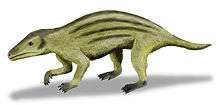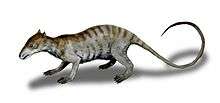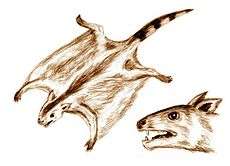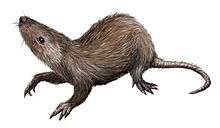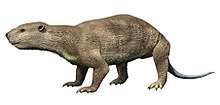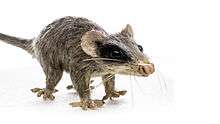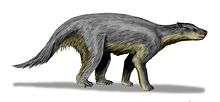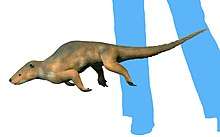Neoplagiaulacidae
Neoplagiaulacidae is a family of mammal within the extinct order Multituberculata. Fossil remains are known from the Upper Cretaceous through to the latest Eocene/early Oligocene. Representatives have been found in North America, Europe and Asia. They are the last multituberculates known.[3]
| Neoplagiaulacidae | |
|---|---|
| Scientific classification | |
| Kingdom: | Animalia |
| Phylum: | Chordata |
| Class: | Mammalia |
| Order: | †Multituberculata |
| Superfamily: | †Ptilodontoidea |
| Family: | †Neoplagiaulacidae |
| Genera | |
Neoplagiaulacinae (Ameghino 1890) has been seen as a sub-family within Ptilodontidae (Cope, 1887). More recent thinking has it as a family. Synonyms are Ectypodidae (Sloan & Van Valen 1965) and Ectypodontidae (Sloan & Van Valen 1965). Most fossils are restricted to teeth. The family is part of the suborder of Cimolodonta within the superfamily of Ptilodontoidea.
Notes
- Hunter, J. P; Heinrich, R. E. & Weishampel, D. B. (2010). "Mammals from the St. Mary River Formation (Upper Cretaceous), Montana". Journal of Vertebrate Paleontology. 30 (3): 885–898. doi:10.1080/02724631003763490.
- Wilson, G. P.; Dechesne, M. & Anderson, I. R. (2010). "New Late Cretaceous mammals from northeastern Colorado with biochronologic and biogeographic implications". Journal of Vertebrate Paleontology. 30 (2): 499–520. doi:10.1080/02724631003620955.
- Karew Schumaker, Multituberculates from the Medicine Pole Hills Local Fauna (Chadronian) of Bowman County, North Dakota
References
- Ameghino (1890). "Los plagiaulácidos Argentinos y sus relaciones zoológicas, geológicas y geográficas". Boletin del Instituto Geográfico Argentino. 11: 143–208.
- Kielan-Jaworowska Z.; Hurum J.H. (2001). "Phylogeny and Systematics of multituberculate mammals". Palaeontology. 44 (3): 389–429. doi:10.1111/1475-4983.00185.
This article is issued from Wikipedia. The text is licensed under Creative Commons - Attribution - Sharealike. Additional terms may apply for the media files.

